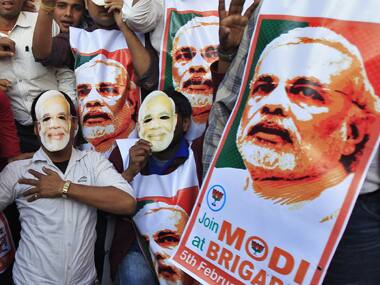If you have been listening to radio recently, then you would have heard the barrage of ads paid for by the Uttar Pradesh government. The ads start by talking about how the police in the state have now been given Innovas and new bikes to counter crime in the state, and they all end by thanking Chief Minister Akhilesh Yadav for his initiatives; thanking him as if fighting crime in his state isn’t part of his job description. Now, thanks to the Supreme Court we may see the end of such blatant self-promotion — by political parties and politicians. The apex court on Wednesday prohibited the use of photographs of political leaders, including ministers, in advertisements issued by the government and its agencies, saying that it leads to the promotion of a personality cult. [caption id=“attachment_2242126” align=“alignleft” width=“380” class=" “]  Representational image. Reuters[/caption] The apex court bench, headed by Justice Ranjan Gogoi, in its judgement, however, permitted the use of photographs of the president, prime minister, Chief Justice of India and departed leaders, including Mahatma Gandhi, in such advertisements. The Supreme Court had set up an expert committee last year to offer recommendations on the matter and the order is a direct result of its findings. The court also said such self-promotional advertising is a direct injustice to democracy. The judgement was issued in response to a petition filed by lawyer-activist Prashant Bhushan, who sought strict rules to check the misuse of taxpayers’ money by those in power. “All those state governments which have put up ads and hoardings at the taxpayers’ expense with photos of chief ministers and party leaders will now have to pull them down,” Bhushan told reporters after the verdict. According to a report in Mint, “The United Progressive Alliance government, ousted in the April-May general election. spent nearly Rs.143 crore to commemorate the birth or death anniversaries of 15 late leaders in the five-year period from 2008-09 to 2012-13, according to data from the Directorate of Advertising and Visual Publicity. The maximum spending, roughly about a quarter of the Rs.143 crore, was in the name of Mahatma Gandhi. The second and third highest amounts were spent on advertisements to commemorate Rajiv Gandhi and Indira Gandhi.” The UPA government was not the only guilty party. In a little over a month, the current NDA government spent over Rs 40 crore on advertising Prime Minister Narendra Modi’s ambitious Swachh Bharat Abhiyan. BJP-run state governments have acted exactly in the same fashion as their Congress rivals. For example, as reported by NDTV, between 2007 and 2011, in Uttarakhand, the then BJP government spent Rs. 62 lakh for advertisements for Atal Bihari Vajpayee. And between 2002 to 2012, the state spent Rs. 10 crore on remembering other BJP leaders. Remember all this expenditure came at the tax-payers expense and without any accountability or oversight. The public sector and even some ministries have generously opened their coffers as well for expensive advertising campaigns. While parts of the country are still in the dark, the Power Ministry spent Rs. 3.1 crore in just two years between 2008-2009. In fact, the Tourism Ministry spent one crore in 2011 on Rajiv Gandhi’s death and birth anniversaries — events that are hardly high on tourism value. So the SC judgement cracking down on this wasteful expense t is certainly welcome. However, it leaves intact one giant loophole that can be used to leverage taxpayer money toward political ends, i.e. the permission to use the PM’s image. Putting Narendra Modi’s face in government ads is undoubtedly going to help the ruling party. The PM is the face of the BJP, he has campaigned for them in every state, he is the BJP. If his face is now going to be plastered onto government ads (at least in BJP states and in central government ads), is it not allowing one politician to further his own personality cult? Furthermore, by prohibiting the use of any other politician’s image, it incentivises the use of Modi’s visage in such advertising. The Supreme Court rejected the recommendation of one committee member, eminent academician Prof N R Madhava Menon, that government advertisements should not carry photographs of any dignitaries including the President and the Prime Minister. They were wrong to do so. The fact of the matter is that unlike the CJI or the President, a Prime Minister is an elected leader who stands to gain political profit from having his image associated with government schemes and policies. If Modi is the face attached in popular imagination to the state or central government’s largesse – and in one tax-payer funded advertisement after another – it gives him and his party an unfair advantage in future elections. While other parties may have to spend their own cash for ads, the BJP gets to turn Modi into a taxpayer-funded poster boy, and in the literal sense of the word. Surely that is doing no service to democracy.
The SC bench permitted the use of photographs of Pranab Mukherjee, Narendra Modi and the Chief Justice of India and departed leaders, including Mahatma Gandhi, in such advertisements.
Advertisement
End of Article


)
)
)
)
)
)
)
)
)



